

|
Soundclip:
|
| See Steve's Hand-Written Solo
Transcription |
|
Steve Khan's solo on: "Think of One"(Thelonious Monk) It's hard to explain just how fortunate I feel that BGO Records(UK) has just released the 3rd in a series of reissues on my recordings that will span the late '70s, the early '80s, and now the mid-'90s. It is especially great because it follows on the heels of my most recent album, "BACKLOG." 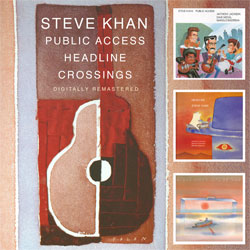 This new reissue embraces what I would refer to as the Eyewitness2 period from "PUBLIC ACCESS"('89) with Dave Weckl on drums; to "HEADLINE"('92) and finally "CROSSINGS"('94) both featuring Dennis Chambers on drums. The music on all of these albums represented a deepening of our music-making concepts and the further exploration of feeling the presence of essential Latin elements in the music. "CROSSINGS" was probably the first full representation of that kind of expression. Yes, one could say that the ballads: "Pee Wee" and "Melancholee" had little or nothing to do with Latin music, and that would be true - but, the rest of music? It most certainly had Latin influences and feels. This new reissue embraces what I would refer to as the Eyewitness2 period from "PUBLIC ACCESS"('89) with Dave Weckl on drums; to "HEADLINE"('92) and finally "CROSSINGS"('94) both featuring Dennis Chambers on drums. The music on all of these albums represented a deepening of our music-making concepts and the further exploration of feeling the presence of essential Latin elements in the music. "CROSSINGS" was probably the first full representation of that kind of expression. Yes, one could say that the ballads: "Pee Wee" and "Melancholee" had little or nothing to do with Latin music, and that would be true - but, the rest of music? It most certainly had Latin influences and feels.To fanfare the announcement of this reissue release, I wanted to present something from "CROSSINGS" and, after some thought, I felt that the best way to represent the music that we had played then would be to share a transcription of the solo on "Think of One" by Thelonious Monk. I chose this solo because it embodies so much of our style of music-making, and my own approach to interpreting a classic Jazz standard. But no matter how much thought and care I might put into all the details, there is no way to do this without the input and playing of: Anthony Jackson(Contrabass Guitar), Dennis Chambers(Drums), and Manolo Badrena(Percussion). The arrangement of "Think of One" and its conversion to becoming a Latin Jazz tune really felt very organic to me as many of Monk's phrases seem to fall comfortably into a Latin even 8th-note feel. The key element is that Dennis is playing a 1/2-time Latin Funk groove with his cowbell hitting on beats 1 and 3. On many of Monk's classic tunes, players seem to want to replicate the composer's adherence to soloing over the strict format laid-out in the melody statement. This tune falls into the standard 32-bar [A]-[A]-[B]-[A] format. For me, I am always looking for ways to retain the feeling generated by the piece, but opening it up a bit to make it even more loose. In order to accomplish that, I decided that in all the letter [A] sections, I would only hint at some of the chords in the melody and just leave Anthony with a bar of F or F7 to a bar of Eb7. Those two changes would appear in bars 1-2 and 5-6 each time. The rest of the tune sticks rather closely to Monk's original changes. In each chorus, in bars 7-8 of [A2] and [A3], Anthony, Dennis and I are free to play the figures that appear in the melody, or to ignore them, and this detail adds the element of surprise to each chorus as I never knew what they might do, and they could never be certain that I might play the figures or not. I chose this performance to present here because it embodies so much of what Anthony, Dennis, Manolo and I seem to be able to do when we come together to play. Yes, there is some discussion and rehearsing of various details, large and small, but over all, it is what is left unsaid that finds its way into most performances. However one comes to hear it and view it, this is what we do, this is what we did! Chorus 1 of the solo begins with putting to use a paraphrase of the 1st bar of Monk's melody for any of the [A] sections. Notice that in bar 3, the chordal punctuation is in a style very much influenced by McCoy Tyner and consistent with how I had been approaching playing for years before and right up to the present. The flurry of 16th-notes in bar 4 are very much derived from the C altered dominant scale [C, Db, Eb, E, Gb, Ab, Bb]. In bars 7-8, the two little arpeggiated sweeps embrace different aspects of the F7(b5) written chord. In bar 7, you hear a 7b9 sensibility, and then, in bar 8, the sweep involves a B7 chord, the b5 substitute for F7. At this point, notice how both Anthony and Dennis are focused on making the music feel good, and creating a rhythmic flow that is consistent with the melodic sections that preceded the solo. As [A2] begins, ideas from the prior 8-bars are developed. The little sweep in bar 2, down a Bb7 chord, demonstrates that Monk's 2nd chord in the melody can be alluded to, or brushed by, even if we are, in a sense, ignoring it. In bars 3-4, the chordal punctuations reappear with an addition using Gm7 voicings in this style over where there could be a C7 chord. At the end of bar 4, F to B-natural, played in octaves, connects to Monk's melodic material, and is a huge part of my arrangement as well. In bar 5, I am playing in the modal area of B Mixolydian [B, C#, D#, E, F#, G#, A] which is not too far away from some of the whole-tone ideas that Monk always loved to insert in his tunes and his playing. So, the F whole tone scale [F, G, A, B, C#, Eb] can be seen as part of this approach too. At bar 7, the ensemble observes one of the main figures from the arrangement. As I previously stated, this can appear there, or not - it is optional. As I make the transition to the next section, the 16th-notes are still focused around B Mixolydian, but in the middle of bar 8, on beat 3, the line moves to the F altered dominant scale [F, Gb, Ab, A, B, C#, Eb]. As we are headed to an area of Bb major, this makes some degree of sense. The approach to the 1st 4 bars of [B], which is a ii-V-I-VI7(alt.) in Bb major, begins with a sense of C Dorian [C, D, Eb, F, G, A, Bb] over the Cm7 chord, and again, I am employing a sense of B Mixolydian, or F# Dorian [F#, G#, A, B, C#, D#, E], as I transit towards Bb major. 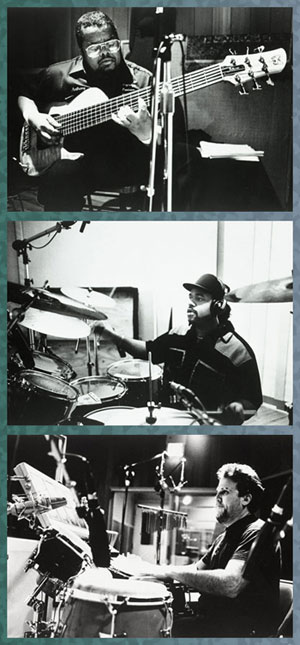 The interesting thing is that I never really arrive there. From the end of bar 3 into bar 4, I am putting to use F altered dominant. Then, in bars 5-6, over what is a G7(b5) area, you hear more of a sense of whole-tone elements with an F7 sweep followed by a G7 sweep. And even though the chords in bars 7-8 are Gm7-C7, a ii-V to take us back to F7, in bar 7, you see a B7 sweep. Finally in bar 8, you even see an A7 arpeggio, which has notes in related to C7(alt.) [G(5th), C#(b9), E(3rd), A(13th)]. Notice the texture created by Anthony's usage of octaves. You should also feel is that the intensity level is now picking-up from Dennis, and he is fully engaged. The interesting thing is that I never really arrive there. From the end of bar 3 into bar 4, I am putting to use F altered dominant. Then, in bars 5-6, over what is a G7(b5) area, you hear more of a sense of whole-tone elements with an F7 sweep followed by a G7 sweep. And even though the chords in bars 7-8 are Gm7-C7, a ii-V to take us back to F7, in bar 7, you see a B7 sweep. Finally in bar 8, you even see an A7 arpeggio, which has notes in related to C7(alt.) [G(5th), C#(b9), E(3rd), A(13th)]. Notice the texture created by Anthony's usage of octaves. You should also feel is that the intensity level is now picking-up from Dennis, and he is fully engaged.Finally I resolve to F7 in bar 1 of [A3] a sequence of descending major triads begins from F to Eb, and to Db. This is all about letting the line play you, and following where it might lead. At the end of bar 2, you see 3 notes: Gb-Cb-Db which, to me, indicate a sense of Abm7(sus) (the ii of Db7, which is where we are going to pass through in the coming bar 3). In bars 3-4, the now familiar chordal punctuations appear with different rhythmic placement than they had appeared within [A2]. In bars 5-6, I am again alluding to C Dorian over the F7 chord, but as the chord changes to Eb7 in bar 2, the modal sense becomes something closer to Bb Dorian [Bb, C, D, Eb, F, G, Ab], though the inclusion of some A-naturals might lead one to suspect more of Bb melodic minor [Bb, C, Db, Eb, F, G, A]. As I take a breath on the downbeat of bar 7, you can hear Anthony and Dennis playing a 2nd figure that comes from the original melody statement arrangement. These details give this solo section an added sense of form and structure, and amidst the freedom, those elements are most welcomed by the players and listeners alike. Finally, in bar 8, I do answer Anthony and Dennis with the chordal portion of that same written phrase. The voice-leading of the simple 3-note chords is something that I always associate with the playing of the great organist, Larry Young. Chorus 2 begins with a full 8 bars of chords that carry the melody notes in their top voice. This is, and has always been, a fundamental tenet of how I have come to approach playing, playing the guitar, in a more piano/keyboard-esque fashion. That is to say, the top voice of any chordal sonority carries the same weight as any single-note improvised melody line. To me, this is essential! The passage begins with sonorities that place, relative to the guitar, Cm7(sus) voicings over Anthony's F7, that include an F7(13b5). However, on the and-of-4 in bar 2, finally there is a sense that I am making that Eb7 chord. In bar 3, as I have done in each of the [A] sections prior to this one, I play the 3-note guts of an Ab7(13) chord. Then, in bar 4, I arpeggiate what I think of here as a C7(13b5b9). In bar 6 and 7, I play two descending 7(13) voicings: B7(13) to A7(13), both b5 substitutes for F7, and then Eb7. On the last 2 beats of bar 6, you again hear the little 3-note voicings that bring us to a Db/Eb sound. In bars 7-8, the section concludes with more 3-note voicings, and only F's and Eb's on top with the colors below changing. These are the same kind of sounds that you heard in bars 7-8 of any of the [A] sections of the melody. So, connecting oneself to melodic and harmonic materials that have appeared before is essential to constructing a solo that makes sense in the context of the greater whole. As [A2] begins, the single-note lines return, and the air and the space open-up. One of the nice things about playing over chords where the harmonic movement is moving down by a whole-step is that you can stay in the area of the 1st chord, and it should sound well over the 2nd chord. You can see and hear that I have stayed in the area of C Dorian over both F7 and Eb7 in bars 1-2, and it gives you that nice color of the b5(A) over the Eb7 without making a big deal of its presence. Over bars 3-4, as the chords cycle around: Ab7-Db7-C7-Gb7, I am playing a simple but bluesy 3rd with 'C' on top, and lightly bending up the Ab below. The double-stop idea continues in bar 5, and finally in bars 7-8 over Anthony's beautifully held low B-natural, my own F7(b5#5) voicing, or B7(9b5), depending upon how you choose to view it, percussively echoes sounds introduced in these same bars during the melody. As [B] returns for the 2nd time during the solo, the ii-V to Bbmaj7 is there as well. Over the Cm7, you hear some traditional bebop line configurations, but the F7 chord is negotiated by using lines that allude to F#m7-B7, the b5 sub. After the resolution to Bbmaj7 is completed, there is a jagged intervallic leap from B-natural to Ab(b9) over the G7(alt.) chord in bar 4 and that idea is very much connected to Monk's melody in that same spot. Bars 5-8 are given a full double-time treatment with D melodic minor [D, E, F, G, A, B, C#] being the primary line source over the G7(b5) area for bars 5-6. With more chromaticism, bars 7-8 still employ a sense of G Dorian to C altered dominant scale as I transition back to F7 on bar 1/beat 1 of the coming section. What makes this simple 8-bar section such a wild ride is the beat displacement employed by the great Dennis Chambers - this is pretty incredible playing. At [A3] the bluesy elements return over the 1st two bars, and as Anthony and Dennis continue their conversational playing with me, the double-time lines return in bars 3-4 with more chromaticism, but you can still hear the lines moving through the Db7 to C7(alt.). In bars 5-6, there is again a sense of C Dorian played through both chords, F7 to Eb7. Finally, as this 2nd chorus comes to a close, Anthony and Dennis play the Monk-style arranged figure, while I dance around it using a paraphrase. Pay attention to the texture that Anthony Jackson creates with his usage of octaves as Chorus 3 begins, and as my single-note lines return, there remains the sense of playing across the bar lines. As it has often been the approach throughout this solo, in bars 3-4, chordal punctuations return. This time, on the and-of-4 of bar 3, you see the guts of what could be either G7#9 or Db7(13). In bar 4, there is an arpeggiated C7(13b9) voicing that turns us back around to F7. For bars 5-7, I am playing through the changes F7-Eb7-F7(b5) by using a C Dorian sense over everything. This again gives me the color of the b5(A-natural) over the Eb7 chord. I have to point out the wonderful sense conversational interplay between Anthony, Dennis and Manolo, and their spirit and precision lead me to play a fragment of an idea in bar 8 that becomes the basis for the next section. At [A2], that same fragment gets expanded, and in various but similar forms goes through bars 1-3 descending in whole tone groupings. Each grouping employing its b5 within the motif. In bar 4, another 16th-note flurry that puts to use ideas formed from the C altered dominant scale. In bar 5, after all the complexities that came before, the spelling out of a simple F triad sounds refreshingly new. Then, in bar 7, we all make the figure together, and that leads me to more 3-note voicings with common tones on top, all over Anthony's beautifully placed low F-natural - the root!!! What a concept!!! As we arrived at the 3rd appearance of letter [B], it seems to bring out a brief homage to one my great guitar heroes, Wes Montgomery. Over the now familiar ii-V to Bbmaj7, the Cm7(sus) chord voicing in bar 1 is very much part of Wes' chord bag, but from there, it becomes much more of a mixture of chordal elements that I have developed through my own explorations. Where group music-making is concerned, I love listening to what Anthony hears and plays as the tension of the ascending voicings in bars 5-6 rises over the G7(b5) chord. 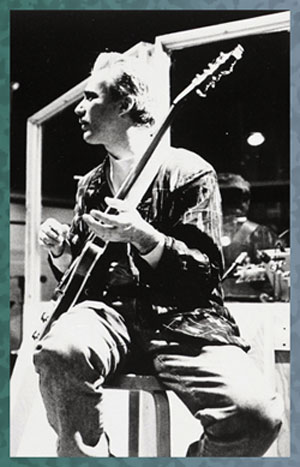 Then, in bar 7-8 over the C7#9(b5) sound, Anthony comes roaring through with his own flourish of 16th-notes, and Dennis picks right on it, and drives us all into the last section of this chorus. Then, in bar 7-8 over the C7#9(b5) sound, Anthony comes roaring through with his own flourish of 16th-notes, and Dennis picks right on it, and drives us all into the last section of this chorus.[A3] sees the solo bring back melodic elements from this great Monk tune. In bar 2, to these ears, there is a moment with a Latin inflection over the Eb7 chord as I play Bbm7sus to Eb7. But then, there is a change in the chordal approach to bars 3-4 as I continue in a ii-V zone playing Ab7(13) to Ebm7(9); then Ab7(13) to Abm7; and on to Db7(9) and to C7#9. In bar 5, there is a more direct paraphrase of Monk's melody that is followed by fully negotiating the Eb7 chord before we all execute the signature break phrase from this arrangement in bar 7. Over Anthony's Gb, I then play a pick-up phrase to take us into the last chorus of the solo. The aforementioned pick-up into Chorus 4 brings back the concept of developing a melodically rhythmic idea. You can't help but notice the inclusion of more triplets in the phrases during the 1st 2 bars. Over the F7, I am applying the C Dorian mode, and over the Eb7, with the inclusion of the Db, I am clearly using Bb Dorian. In bars 3-4, it's nice to see that the lines continue, and this time there are no chordal punctuations. In bar 4, I can clearly see that I'm using C minor pentatonic [C, Eb, F, G, Bb]. This, I believe, is the 1st time that I've even mentioned the word pentatonic during this analysis, and that is rare for a solo of mine! In bars 5-6, there is another burst of 16th-notes, and, after a brief breath, they continue over the F7(b5) chord in bars 7-8. Refreshing your memory, I am using elements from F# Dorian-B Mixolydian, the b5 sub, and finally a piece of F altered dominant to Bb minor pentatonic [Bb, Db, Eb, F, Ab]. As [A2] arrives, I can hear that Anthony is playing a lot of 16th-notes, so my own playing in response becomes more sparse. Bars 3-4 see a return of the chordal punctuations touching on areas of Ab7(13) to Abm7(sus) over the Db7 chord, and then, over the C7 chord, ascending chromatically in those same 4ths voicings until I hit Bb on top. In bars 5-6, I am using richer voicings for Eb/F [F7(9sus)], because of the appearance of F on my A-string. This is followed by Db/Eb [Eb7(9sus)] in bar 6 using the same group of strings. After these chords, on the downbeat of bar 7, you hear Anthony and Dennis make the arranged figure, and then I join in with the expected chordal punctuation. As a pick-up from the last bar of the prior section leads us into letter [B], this time you could say that, because of the diatonic nature of all the notes played, for bars 1-2 and half of bar 3, I am really just playing in Bb major [Bb, C, D, Eb, F, G, A]. There is not a single chromatic note to be found. At least not until the guide tones for G7 [F-B] appear. Then, over the G7(b5) chord for bars 5-6, I resorted to an old guitar whole-tone trick by using my G & B open strings, and then hammering-on notes on those same two strings that are clearly from a whole-tone concept. While that was going on, the intensity level from Anthony and Dennis has ratcheted up another notch which is quite powerful to hear. Over the Gm7-C7 ii-V in bars 7-8, the playing returns to being more melodic, with a nice little note configuration in bar 8 of C(R)-Db(b9)-A(13th), which gives the line a most angular quality as the Db is below the upper C-natural. As the final [A3] begins, Dennis is in full beat displacement mode, which makes everything more interesting. In bars 3-4, I reintroduce short staccato bursts of 16th-note phrases that similarly appeared in [A2] of [Chorus 3]. As the solo winds down, in bars 5-6 I am observing C Dorian over F7, and Bb Dorian over the Eb7 chord. As the solo comes to a close, we all connect together to make the final accents on beat 1-3 of bar 7. As I have mentioned my "Think of One" LEAD SHEETS several times during the course of this analysis, I decided to present here as well, giving the curious amongst you the opportunity to view them for yourself. Looking at them now I am struck by the changes to my music writing "hand" over the past 25 years, or longer, and I see a great improvement. Just look at the difference between the lead sheets and the solo transcription. Of course, every so often, someone will write to me and complain that I am not using Finale or Sibelius, but, as I always explain, I just enjoy doing them by hand. My apologies to those who continue to be upset at me about this. If you end-up owning "CROSSINGS" or the BGO Records reissue and you listen to this performance ALL THE WAY to the end, the ring-out from the last chord, you will hear a very loud SCREAM!!! That is Anthony Jackson, and I believe that, for him when he has given everything that he has to give during a performance, the only release once it's done is just to SCREAM!!! And he does with impunity!!! Except that I left it on the recording. Several years earlier in 1988 when we recorded "Blue Zone 41" from "PUBLIC ACCESS" a similar primal scream happened at the end of that performance too. So if you think that you had heard such a thing before, then you are a real fan, because you did!!! One element that some of you might find interesting is about my guitar sound on this recording. For years after "CROSSINGS" was recorded, I had come to feel that the sound, both my individual sound and our group, crafted by the great engineer, James Farber at Skyline's 6th Floor Studio was the best audio sound that I had ever achieved 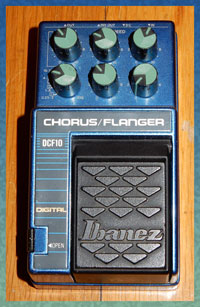 - at least until the recent albums: "PARTING SHOT"(2011); "SUBTEXT"(2014); and most recently "BACKLOG"(2014).This process of the search for a sound really took shape after I had recorded "PUBLIC ACCESS"(1989) and for that entire album, I had used my Bob Bradshaw constructed rack that was about the size of a refrigerator. But, after that album, it wasn't too hard to realize that I would never ever be able to tour with that rack, much less do anything locally either. So, when I sadly had to change formats and went back to playing trio with acoustic bass and drums, my set-up completely changed as well. I don't actually recall when or how it happened, but I know that there was a moment when I fished out my Ibanez DCF-10 - Digital Chorus/Flanger pedal and gave it try - for some insane reason, that was the moment when everything seemed to come together for me! I don't know what it is about this particular "analog" pedal that does this, but when one is playing single-note lines, you barely hear the chorusing effect, but as soon as you play a chord voicing, the pedal seems to open-up and you hear the effect. I began using this pedal on "LET'S CALL THIS"(1991) and the carried forward to "HEADLINE"(1992) and then "CROSSINGS" and into the future, right up to the present!!! As I searched for the perfect balance with this pedal, you can hear that the intensity of the effect became less and less, and less with each successive recording. During the past 10 years of work, it has become less than ever before - and I'm more happy with my sound than ever before! To help those curious, I decided to take a photo of one of my spare DCF-10 pedals with the settings that used for "BACKLOG." If you would like to have them with a bit more precision, please take a moment to visit my EQUIPMENT page, and everything is detailed right there!!! I would tell you that, as the years have come and gone, what I have tended to do is to continue to back-off on the WIDTH and the SPEED controls, moving both of them incrementally to the left. - at least until the recent albums: "PARTING SHOT"(2011); "SUBTEXT"(2014); and most recently "BACKLOG"(2014).This process of the search for a sound really took shape after I had recorded "PUBLIC ACCESS"(1989) and for that entire album, I had used my Bob Bradshaw constructed rack that was about the size of a refrigerator. But, after that album, it wasn't too hard to realize that I would never ever be able to tour with that rack, much less do anything locally either. So, when I sadly had to change formats and went back to playing trio with acoustic bass and drums, my set-up completely changed as well. I don't actually recall when or how it happened, but I know that there was a moment when I fished out my Ibanez DCF-10 - Digital Chorus/Flanger pedal and gave it try - for some insane reason, that was the moment when everything seemed to come together for me! I don't know what it is about this particular "analog" pedal that does this, but when one is playing single-note lines, you barely hear the chorusing effect, but as soon as you play a chord voicing, the pedal seems to open-up and you hear the effect. I began using this pedal on "LET'S CALL THIS"(1991) and the carried forward to "HEADLINE"(1992) and then "CROSSINGS" and into the future, right up to the present!!! As I searched for the perfect balance with this pedal, you can hear that the intensity of the effect became less and less, and less with each successive recording. During the past 10 years of work, it has become less than ever before - and I'm more happy with my sound than ever before! To help those curious, I decided to take a photo of one of my spare DCF-10 pedals with the settings that used for "BACKLOG." If you would like to have them with a bit more precision, please take a moment to visit my EQUIPMENT page, and everything is detailed right there!!! I would tell you that, as the years have come and gone, what I have tended to do is to continue to back-off on the WIDTH and the SPEED controls, moving both of them incrementally to the left.At this point, it bears noting that prior to this transcription presentation, the only other solo to be presented here at KORNER 1 was Michael Brecker's tenor sax solo that appears on Cole Porter's "I Love Paris." 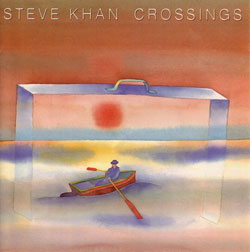 It is one of the great moments on the "CROSSINGS" album and, for those who are not familiar with it, the interplay during the fade is worth the price of admission. Anthony Jackson and Mike take a simple Cm7 montuno to unimagined places - places that even surprised me. Please take the time to investigate it. On another related note, just a couple of months after "CROSSINGS" was recorded, Anthony, Dennis and I went on another European tour, and on the last night of the tour we did a live radio broadcast for WDR in Köln, Germany. What happened after that night's performance and broadcast is pretty remarkable, and some 14 years later, the recording of that very broadcast went on to become the double CD album, "THE SUITCASE." Just follow the link, and you can read all about it. It must be noted that, the only reason that Manolo Badrena did not accompany us on that tour, and many others, was that sadly there just wasn't enough money in the budget to accommodate him. This is something that I will always regret. It is a financial reality that many small musicians like me face. It is one of the great moments on the "CROSSINGS" album and, for those who are not familiar with it, the interplay during the fade is worth the price of admission. Anthony Jackson and Mike take a simple Cm7 montuno to unimagined places - places that even surprised me. Please take the time to investigate it. On another related note, just a couple of months after "CROSSINGS" was recorded, Anthony, Dennis and I went on another European tour, and on the last night of the tour we did a live radio broadcast for WDR in Köln, Germany. What happened after that night's performance and broadcast is pretty remarkable, and some 14 years later, the recording of that very broadcast went on to become the double CD album, "THE SUITCASE." Just follow the link, and you can read all about it. It must be noted that, the only reason that Manolo Badrena did not accompany us on that tour, and many others, was that sadly there just wasn't enough money in the budget to accommodate him. This is something that I will always regret. It is a financial reality that many small musicians like me face.I am so very grateful to BGO Records for doing this reissue, it has really lifted my spirits after a most difficult year in 2017. So, here we are, having arrived at March, 2018, and the weather in the northeast is beginning to warm-up a bit, but our political climate in Washington, DC, becomes more insane with every passing day. 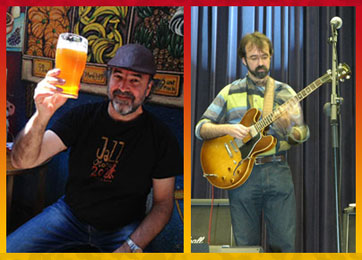 Like everyone else who cares deeply about our country, I have no idea where this is all headed, where things are going to end up, but also like a certain segment of the population, I have felt embarrassed and ashamed of the comportment of our president. We'll see where this all goes. In the meantime, here's wishing all those who visit these pages a very happy springtime!!! While I'm at it, I wanted to add a very special "Thank you!" to DJ Lee Thomas from KCSM-FM which serves the greater San Francisco Bay area for always programming "Think of One" when the mood strikes!!! Like everyone else who cares deeply about our country, I have no idea where this is all headed, where things are going to end up, but also like a certain segment of the population, I have felt embarrassed and ashamed of the comportment of our president. We'll see where this all goes. In the meantime, here's wishing all those who visit these pages a very happy springtime!!! While I'm at it, I wanted to add a very special "Thank you!" to DJ Lee Thomas from KCSM-FM which serves the greater San Francisco Bay area for always programming "Think of One" when the mood strikes!!!In Memoriam: If you will allow me, I want to dedicate this post to the memory of my beloved friend since 1998, Felipe Díaz Reyes, who passed away suddenly yesterday, February 28th, 2018 in Las Palmas, Gran Canarias, Spain. He was a warm and wonderful man, a scientist, professor, guitar lover, and serious Jazz fan, but above all, someone with great compassion and a huge heart. He is survived by his two greatest treasures, his dear wife, Isabel, and his fantastic daughter, Naima. My heartfelt sympathies go out to them, and to his extended family and friends. I'm just so sad since receiving this news, and I am going to miss him a great deal. He has been so wonderful to me throughout all of these years. Felipe, hermano, rest in peace, and know that you were loved here on this earth by many - including me!!!
[Photos: Anthony Jackson-Dennis Chambers-Manolo Badrena Collage
Steve Khan - Photo by: David Tan @ Skyline Studios, December 29-30, 1993] Felipe Díaz Reyes collage: [L] with a favorite cerveza and [R] Playing my guitar in 2005 in Las Palmas at the soundcheck!!! Vaya Felipe!!! |